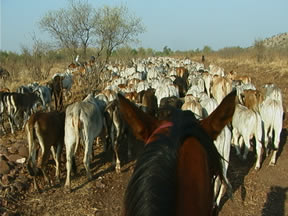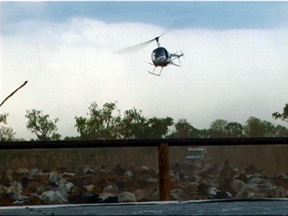
Moolooloo
Cattle Station, Victoria River Downs District, Northern Territory
“Its
not exactly human power, but it certainly beats pedalling for a
change.” This was the thought that popped into my head as I
climbed into the saddle of a beautiful thoroughbred gelding lent
for me to help out with the day’s work: herding cattle on horseback.
Jason and I had left the rest of the group at Limestone Gorge in
Gregory National Park for the weekend to go and explore a typical
Australian cattle station. We were now tailing some 500 head of
‘weaner’ calves 23 kilometres to a yard where they would
be ‘drafted’ (sorted) and put out into a different paddock
to the one they’d been born and raised in.
 |
So,
for the next 48 hours we got to sample a little of the life to be
had on a Northern Territory Cattle Station; from gnawing dinosaur
bones at the Saturday night BBQ to having a cardiac arrest on the
toilet following the hasty exit of a large, green frog from the
underside of the seat. The highpoint however had to be the following
afternoon when we were lucky to experience the art of mustering
cattle (gathering together) by helicopter. Dark storm clouds were
already forming on the horizon as we drove the rough, 30 km track
to the yard where the cattle were being mustered. Heli-mustering
is quite a recent technique used for gathering cattle from huge
paddocks - several hundred square kilometres in size – into
holding pens for necessary maintenance/sorting.
The paddock in this case had the added disadvantage - at least from
the perspective of being worked by horseback – of being covered
ankle deep in rocks. So mustering by helicopter often not only saves
time but ultimately also money (see today’s math update ‘Ringer
for a Day’).
 |
After
making contact on a UHF radio we met up with Mark Clifford, the
Station Manager, who kindly allowed me to go up in one of the choppers
to see how mustering was done from the air. After a quick 4-minute
up and down the pilot set me down on one of the yard roofs to watch
the final ‘yarding-up’ process of squeezing the mustered
cattle the last few hundred yards through a funnel into the holding
pens. Bear in mind these cattle are mustered only once a year, having
human contact for only a few days in every 365. So for all intents
and purposes they are as wild as cattle can get. All parties present
were then treated in the closing stages to a truly spectacular
display of acrobatics as the chopper pilot engaged in an air-to-land
dogfight with a rogue mother and calf that had absolutely no interest
in joining her colleagues in the pens. As the clattering machine
ducked and weaved just a few feet above the ground to cut the mother
from double-backing, spinning first this way then that, the mother
cow likewise spun and gyrated to shake off the chopper, occasionally
raising her head skyward to shake it in defiance of this airborne
threat to her offspring.
Finally the mother’s efforts
prevailed and she escaped behind the chopper, her calf managing
to barge through the fence to freedom into a neighbouring paddock.
“No worries”, said Mark as we all congregated in the pouring
rain beside the pens, now filled to the brim with steaming animals.
“The ringers will probably pick them up later this week during
drafting”.
Half an hour later after the rain
had eased we slowly made our way through the mud to the homestead.
Barb – the station’s cook – was waiting for us with
a welcome cup of hot tea and Anzac biscuits. We then bade our farewells
and started the long ride back to meet up with the rest of the team
at Limestone Gorge.
April
- journal entry
|